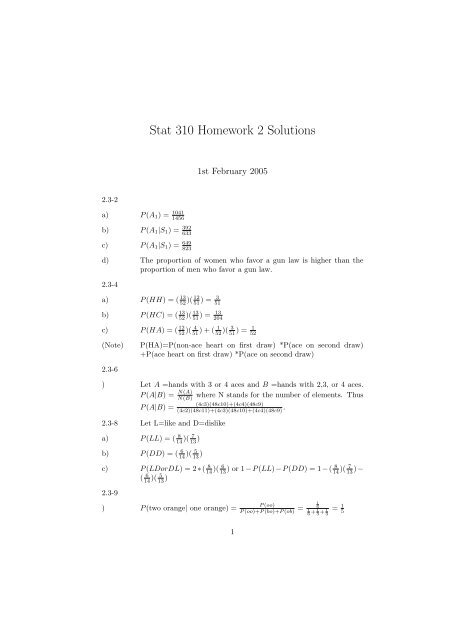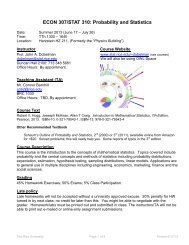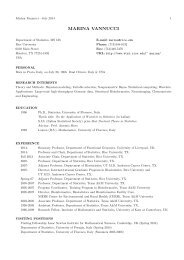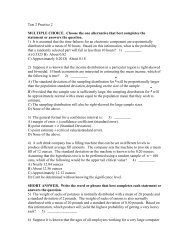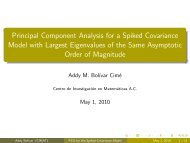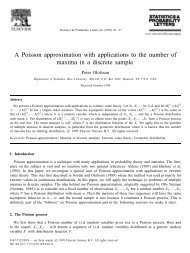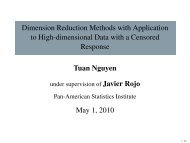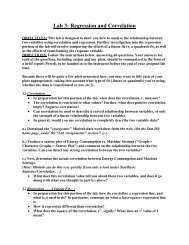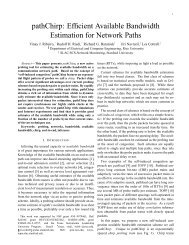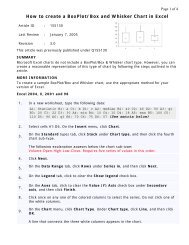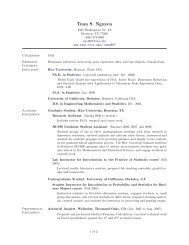Stat 310 Homework 2 Solutions
Stat 310 Homework 2 Solutions
Stat 310 Homework 2 Solutions
- No tags were found...
Create successful ePaper yourself
Turn your PDF publications into a flip-book with our unique Google optimized e-Paper software.
<strong>Stat</strong> <strong>310</strong> <strong>Homework</strong> 2 <strong>Solutions</strong>1st February 20052.3-2a) P (A 1 ) = 10411456b) P (A 1 |S 1 ) = 392633c) P (A 1 |S 1 ) = 649823d) The proportion of women who favor a gun law is higher than theproportion of men who favor a gun law.2.3-4a) P (HH) = ( 13 1252)(51 ) = 351b) P (HC) = ( 13 1352)(51 ) = 13204c) P (HA) = ( 1252 )( 451 ) + ( 152 )( 351 ) = 152(Note)2.3-6P(HA)=P(non-ace heart on first draw) *P(ace on second draw)+P(ace heart on first draw) *P(ace on second draw)) Let A =hands with 3 or 4 aces and B =hands with 2,3, or 4 aces.P (A|B) = N(A)N(B)where N stands for the number of elements. ThusP (A|B) =2.3-8 Let L=like and D=dislikea) P (LL) = ( 814 )( 713 )b) P (DD) = ( 614 )( 513 )c) P (LDorDL) = 2 ∗ ( 8( 614 )( 513 )2.3-9(4c3)(48c10)+(4c4)(48c9)(4c2)(48c11)+(4c3)(48c10)+(4c4)(48c9) .14 )( 613) P (two orange| one orange) =) or 1 − P (LL) − P (DD) = 1 − (814 )( 713 ) −1P (oo)P (oo)+P (bo)+P (ob) = 161 = 16 + 1 3 + 1 53
2.3-13a) S={(1 1),(1 2),(1 3),(1 4),(1 5),(1 6),(2 1), (2 2), (2 3), (2 4), (2 5),(2 6),(3 1),(3 2),(3 3),(3 4),(3 5), (3 6),(4 1), (4 2), (4 3), (4 4), (45), (4 6), (5 1), (5 2), (5 3), (5 4), (5 5), (5 6),(6 1), (6 2), (6 3), (64), (6 5), (6 6)}b) P (7or11) = 836 = 2 9c) P (8|7or8) = 5 361136total either 7 or 8)d) P (8)P (7or8) = 5in c)= 51136 ∗ 511(There are 5 choices with total 8 and 11 that55(P (8) =36and P (8|7or8) =11are explainede) P (win) = P (7or11)+P (2)P (2|7or2)+P (3)P (3|7or3)+P (4)(4|7or4)) +P (5)(5|7or5) + P (6)P (6|7or6) + P (8)(8|7or8) + P (9)(9|7or9)) +P (10)(10|7or10) + P (12)(12|7or12)) P (win) = 2 9 + 2[ 536 ∗ 511 + 436 ∗ 410 + 336 ∗ 3 9 ] = 0.492932.3-16a) The probability of drawing blue is the same for all 3 (= 118), so itdoesn’t matter.b) All the probabilities are the same (= 1 9 )Section 2.42.4-3a) P (A ∩ B) = 1 4 ∗ 2 3b) P (A ∩ B ′ ) = 1 4 ∗ 1 3c) P (A ′ ∩ B ′ ) = 3 4 ∗ 1 3d) P ((A ∪ B) ′ ) = P (A ′ ∩ B ′ ) = 3 4 ∗ 1 3e) P (A ′ ∩ B) = 3 4 ∗ 2 32.4-8 P (exactly2orange) = P (A, B = o, C = b) + P (B, C = o, A = b)) +P (A, C = o, B = b) = 1 6 ∗ 1 3 ∗ 1 2 + 5 6 ∗ 1 3 ∗ 1 2 + 1 6 ∗ 2 3 ∗ 1 2 = 2 92.4-11a) No. If P (A)and P (B)are both> 0, then A and B are never bothindependent and mutually exclusive since P (A)P (B) > P (A ∩ B) =0.2
) If A ⊂ B, then P (A ∩ B) = P (A), and P (A ∩ B) = P (A)P (B) areequivalent only when P (B) = 1or P (A) = 0.2.4-16a) When drawing with replacement you can possibly win on every otherdraw starting with the first one.) P (win) = ( 1 5 ) + ( 1 5 )( 4 5 )2 + ( 1 5 )( 4 5 )4 + ( 1 5 )( 4 5 )6 + .......) Thus P (win) = ( 1 5 ) ∑ ( 4 5 )2k for k=0,1,2,... So, P (win) = 5 9b) With replacement, you can possibly win on the first, second, or thirddraw) P (win) = ( 1 5 ) + ( 4 5 )( 3 4 )( 1 3 ) + ( 4 5 )( 3 4 )( 2 3 )( 1 2 ) = 3 53


